inflation pressure AUDI S6 2015 Owners Manual
[x] Cancel search | Manufacturer: AUDI, Model Year: 2015, Model line: S6, Model: AUDI S6 2015Pages: 314, PDF Size: 77.57 MB
Page 135 of 314
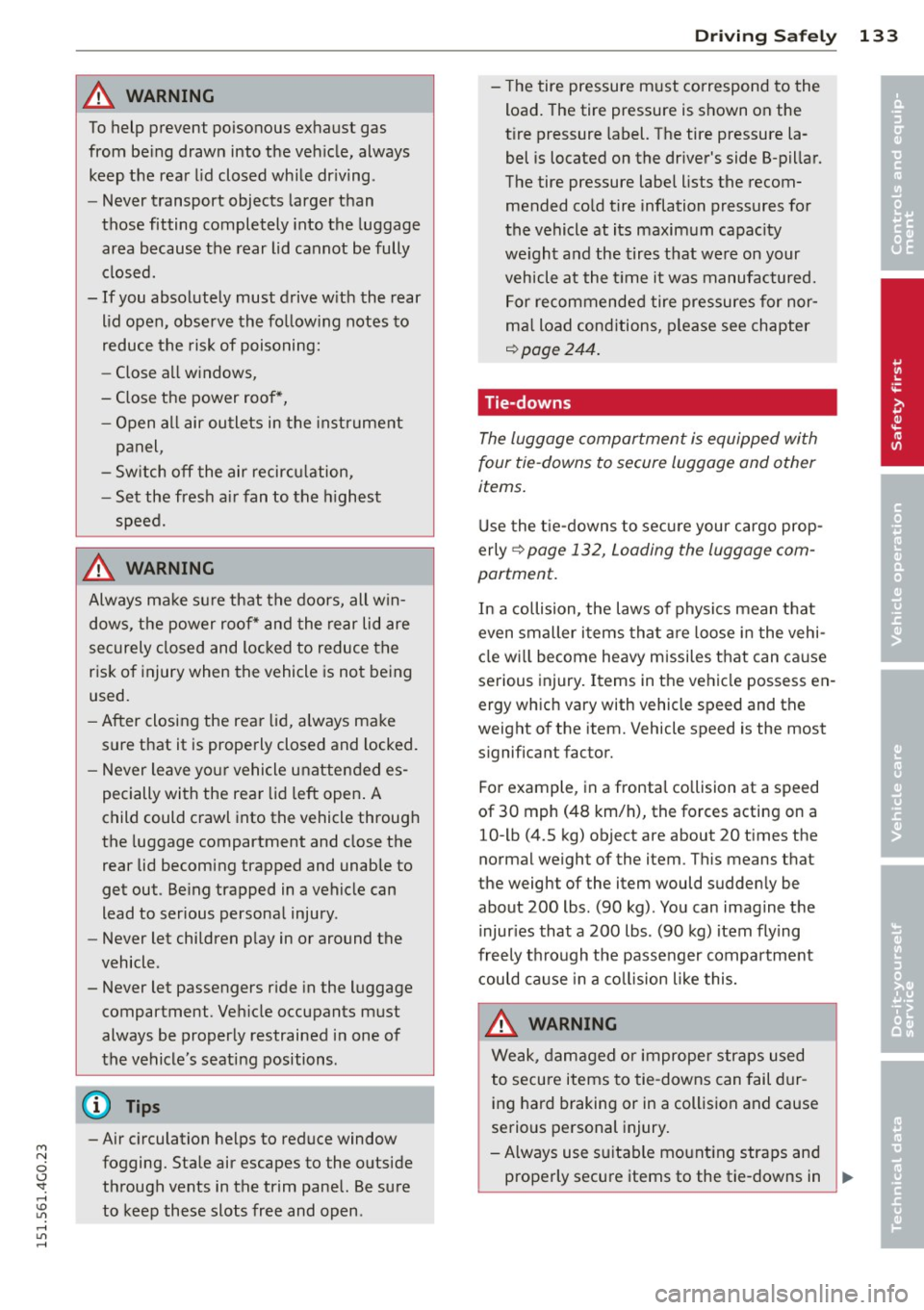
M N
0 <.J 'SI: ,...., \!) 1.1'1 ,...., 1.1'1 ,....,
A WARNING
To help prevent poisonous exhaust gas
from being drawn into the vehicle, always keep the rear lid closed while driving .
- Never transport objects larger than
those fitting completely into the luggage
area because the rear lid cannot be fully
closed.
- If you absolutely must drive with the rear
lid open, observe the following notes to
reduce the risk of poisoning:
- Close all windows,
- Close the power roof*,
- Open all air outlets in the instrument
panel,
- Switch off the air recirculation,
- Set the fresh air fan to the highest
speed.
A WARNING
Always make sure that the doors, all win dows, the power roof* and the rear lid are
securely closed and locked to reduce the
risk of injury when the vehicle is not being
used.
- After closing the rear lid, always make
sure that it is properly closed and locked.
- Never leave your vehicle unattended es
pecially with the rear lid left open. A
child could crawl into the vehicle through
the luggage compartment and close the
rear lid becoming trapped and unable to
get out. Being trapped in a vehicle can
lead to serious personal injury.
- Never let children play in or around the
vehicle .
- Never let passengers ride in the luggage
compartment. Vehicle occupants must
always be properly restrained in one of
the vehicle's seating positions.
Gj) Tips
-Air circulation helps to reduce window
fogging. Stale air escapes to the outside
through vents in the trim panel. Be sure
to keep these slots free and open .
-
Driving Safely 133
-The tire pressure must correspond to the
load. The tire pressure is shown on the
tire pressure label. The tire pressure la
bel is located on the driver's side B-pillar.
The tire pressure label lists the recom
mended cold tire inflation pressures for
the vehicle at its maximum capacity
weight and the tires that were on your
vehicle at the time it was manufactured.
For recommended tire pressures for nor
mal load conditions, please see chapter
~page 244.
Tie-downs
The luggage compartment is equipped with
four tie-downs to secure luggage and other
items.
Use the tie-downs to secure your cargo prop
erly~
page 132, Loading the luggage com
partment.
In a collision, the laws of physics mean that
even smaller items that are loose in the vehi
cle will become heavy missiles that can cause
serious injury. Items in the vehicle possess en
ergy which vary with vehicle speed and the
weight of the item. Vehicle speed is the most
significant factor.
For example , in a frontal collision at a speed
of 30 mph (48 km/h), the forces acting on a
10-lb (4.5 kg) object are about 20 times the
normal weight of the item. This means that
the weight of the item would suddenly be about 200 lbs. (90 kg) . You can imagine the
injuries that a 200 lbs . (90 kg) item flying
freely through the passenger compartment
could cause in a collision like this.
A WARNING
Weak, damaged or improper straps used
to secure items to tie-downs can fail dur
ing hard braking or in a collision and cause
serious personal injury.
-Always use suitable mounting straps and properly secure items to the tie-downs in
.
•
•
Page 242 of 314
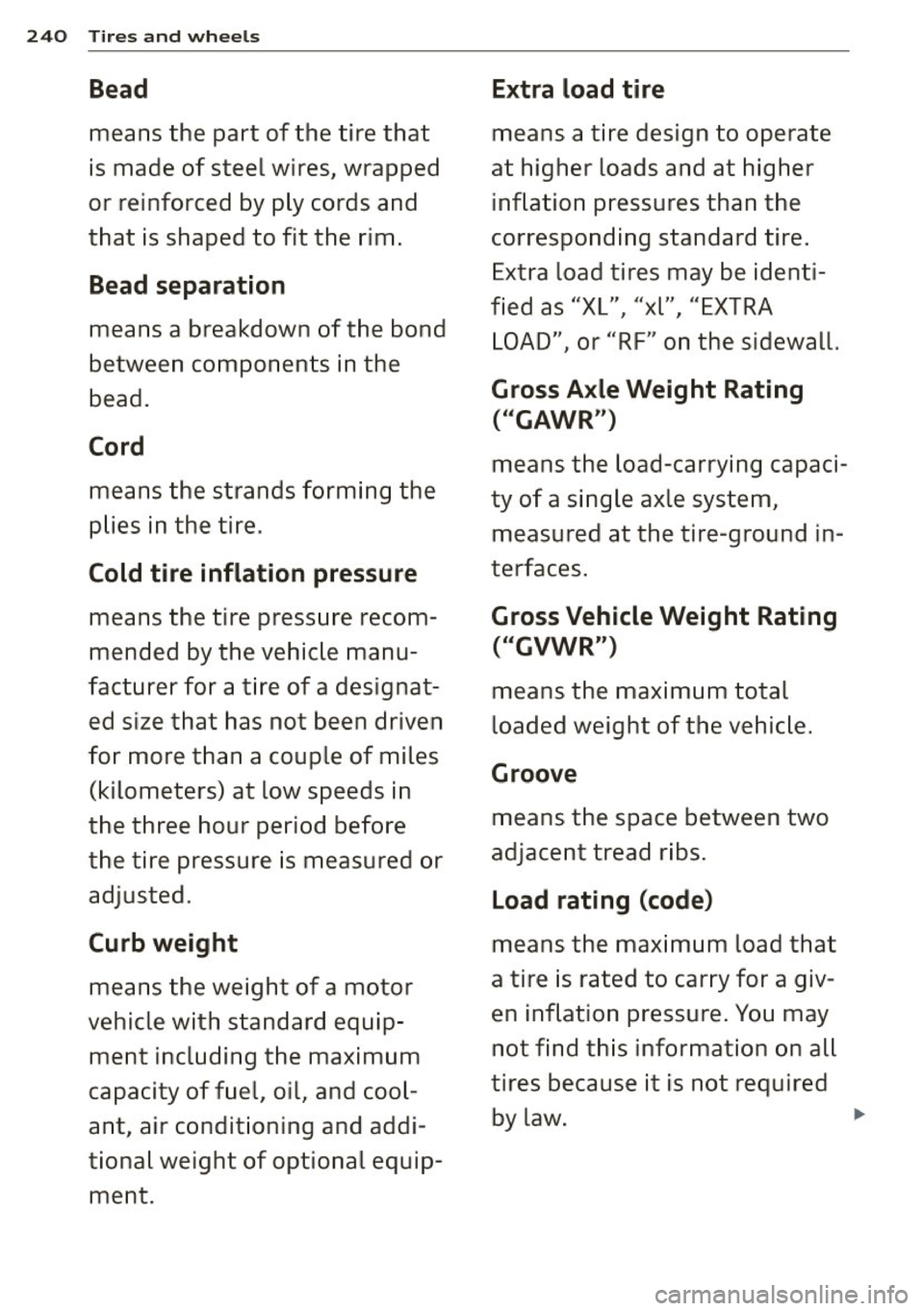
240 Tires and whee ls
Be ad Extra load t ire
means the part of the tire that means a tire design to operate
is made of steel wires, wrapped at higher loads and at higher
or reinforced by ply cords and inflation pressures than the
that is shaped to fit the rim . corresponding standard tire.
Bead separation Extra load tires may be identi-
fied as "XL", "xl", "EXTRA
means a breakdown of the bond LOAD", or "RF" on the sidewall.
between components in the
bead .
Gross A xle Weight Rating
(" GAWR ")
Cord
means the load-carrying capaci-
means the strands forming the ty of a single axle system,
p lies in the tire .
measured at the tire-ground in-
Cold tire inflation pressure terfaces.
means the tire pressure recom-
Gross Vehicle Weight Rating
mended by the vehicle manu-( "GVWR ")
facturer for a t ire of a designat-
means the maximum total
ed size that has not been driven loaded weight of the vehicle.
for more than a couple of miles
Groove
(kilometers) at low speeds in
the three hour period before means the space between two
the tire pressure is measured or adjacent tread
ribs.
adjusted.
Load rating (code)
Curb weight
means the max imum load that
means the weight of a motor a tire
is rated to carry for a giv-
vehicle with standard equip -en inflation pressure
. You may
ment including the maximum not find
this information on all
capacity of fuel, oil , and cool- tires because it is not required
ant, air conditioning and addi- by law.
...
tiona
l weight of optional equip-
ment.
Page 243 of 314
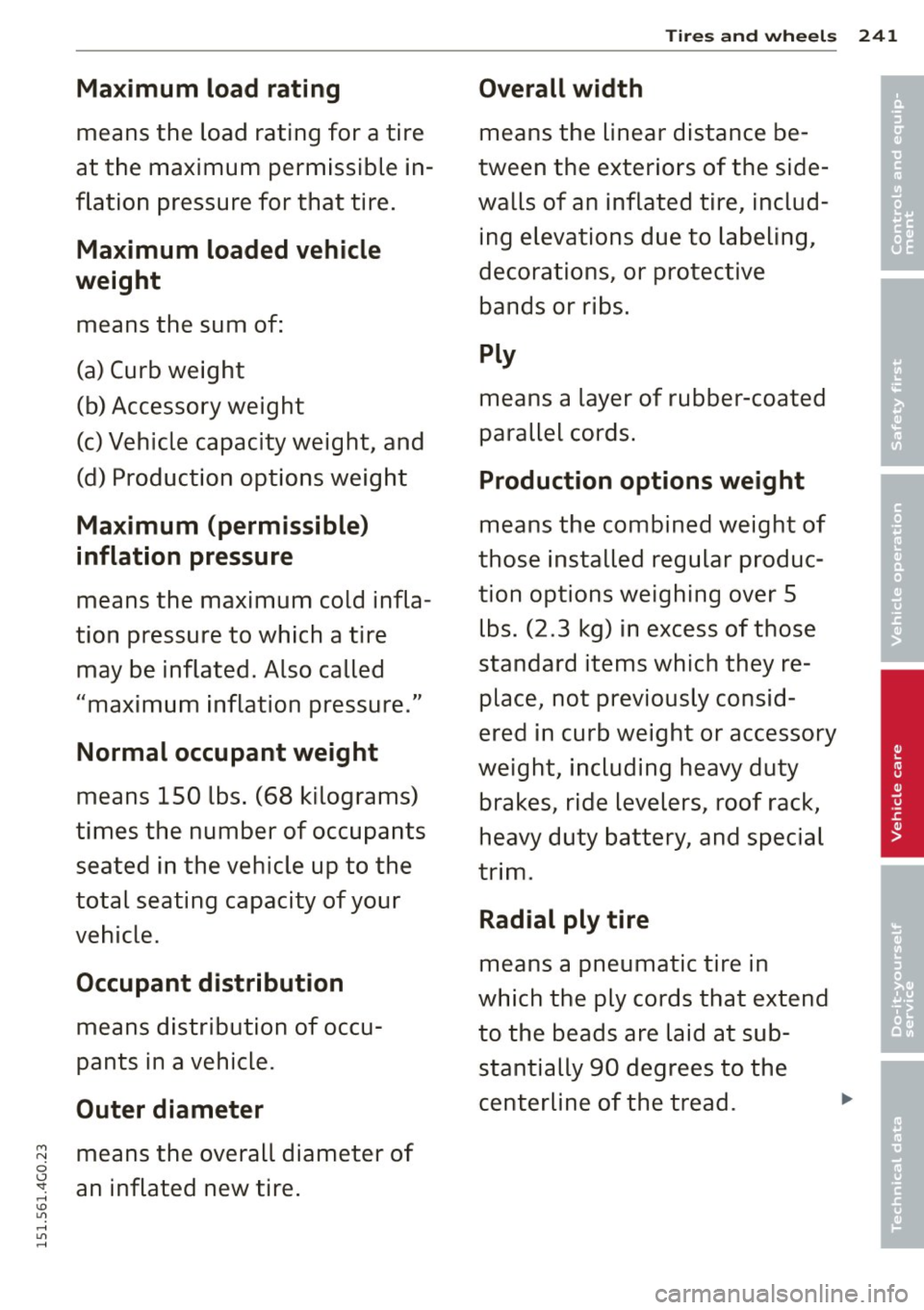
M N
0 <.J 'SI: ,...., \!) 1.1'1 ,...., 1.1'1 ,....,
Maximum load rating
means the load rating for a tire
at the maximum permissible in
flation pressure for that tire.
Maximum loaded vehicle
weight
means the sum of:
(a) Curb weight
(b) Accessory weight
(c) Vehicle capacity weight, and
(d) Production options weight
Maximum (permissible)
inflation pressure
means the maximum cold infla
tion pressure to which a tire
may be inflated. Also called
"maximum inflation pressure."
Normal occupant weight
means 150 lbs. (68 kilograms)
times the number of occupants seated in the vehicle up to the
total seating capacity of your
vehicle.
Occupant distribution
means distribution of occu pants in a vehicle.
Outer diameter
means the overall diameter of
an inflated new tire.
Tires and wheels 241
Overall width
means the linear distance be
tween the exteriors of the side
walls of an inflated tire, includ ing elevations due to labeling,
decorations, or protective bands or ribs.
Ply
means a layer of rubber-coated
parallel cords.
Production options weight
means the combined weight of
those installed regular produc
tion options weighing over 5 lbs. (2 . 3 kg) in excess of those
standard items which they re
place, not previously consid
ered in curb weight or accessory
weight, including heavy duty
brakes, ride levelers, roof rack,
heavy duty battery, and special
trim.
Radial ply tire
means a pneumatic tire in
which the ply cords that extend
to the beads are laid at sub stantially 90 degrees to the
centerline of the tread.
•
•
'
Page 244 of 314
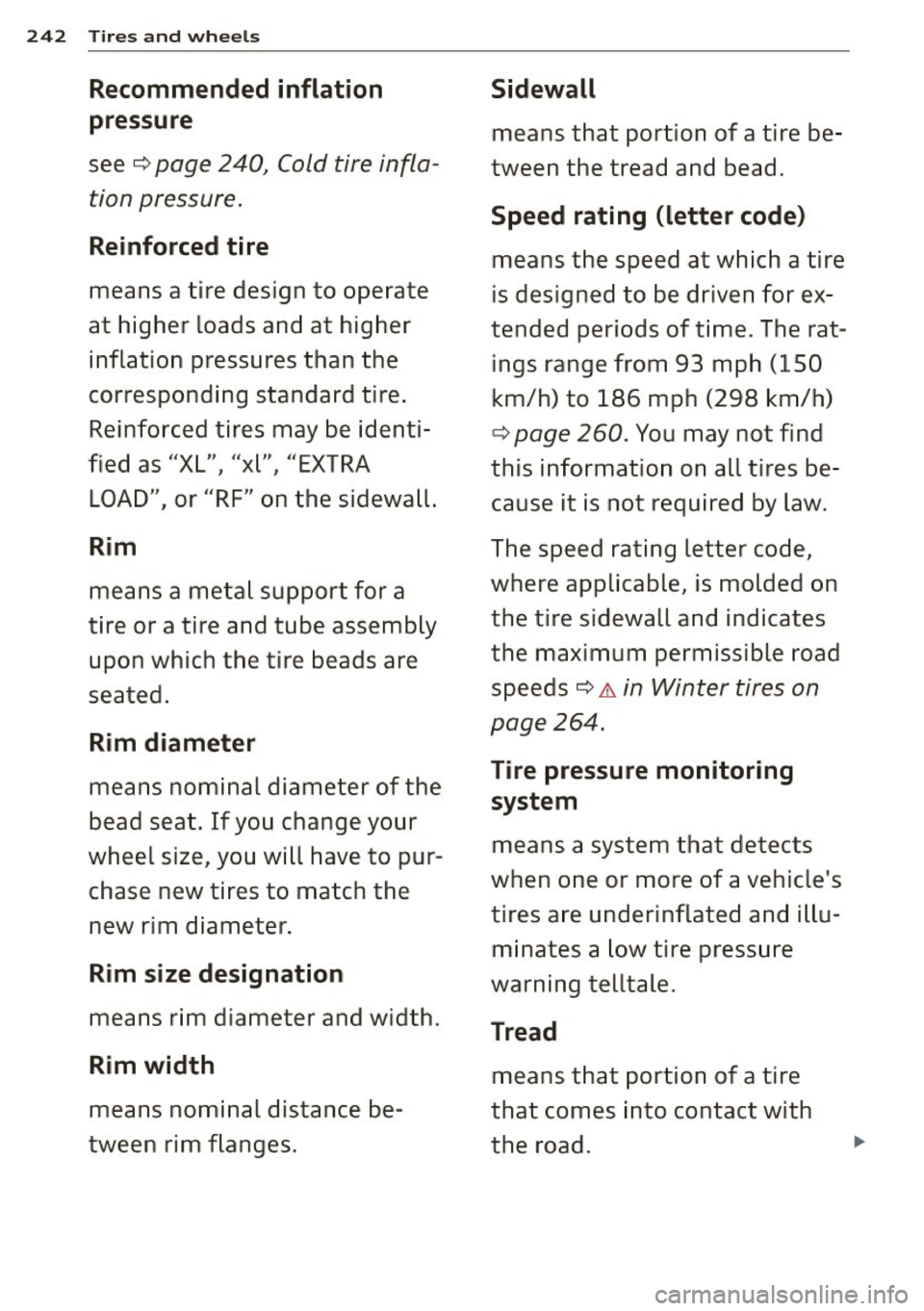
242 Tires and whee ls
Recommended inflation Sidewall
pressu re
means that portion of a tire be -
see
c:::> page 240, Cold tire infla-tween the tread and bead.
tion pressure.
Spe ed rating (letter code )
Reinforced tire
means the speed at which a tire
means a tire design to operate
is designed to be driven for ex-
at higher loads and at higher tended periods of time. The rat-
inflation pressures than the ings range from 93 mph (150
corresponding standard t ire .
km/h) to 186 mph (298 km/h)
Reinforced tires may be identi -
c:::> page 260. You may not find
fied as "XL", "xl", "EXTRA
this information on all tires be-
LOAD", or "RF" on the sidewall.
cause it is not required by law.
Rim The speed rating letter code,
means a meta l support for a where applicable
, is molded on
tire or a tire and tube assembly the tire sidewall and indicates
upon which the tire beads are the
maximum pe rmissible road
seated . speeds
c:::> A in Winter tires on
Rim diameter
page 264.
means
nominal diameter of the
Tire pressure monitoring
system
bead seat. If yo u change your
means a system that detects
wheel size, you will have to pur-
chase new tires to ma tch the when one or more of a vehicle's
new rim diameter . tires a
re underinflated and illu-
Rim size designation
m inates a low tire pressure
warning telltale.
means rim diameter and width.
Tread
Rim width
means that portion of a tire
means nominal distance be-
that comes into contact with
tween rim flanges. the road.
...
Page 246 of 314
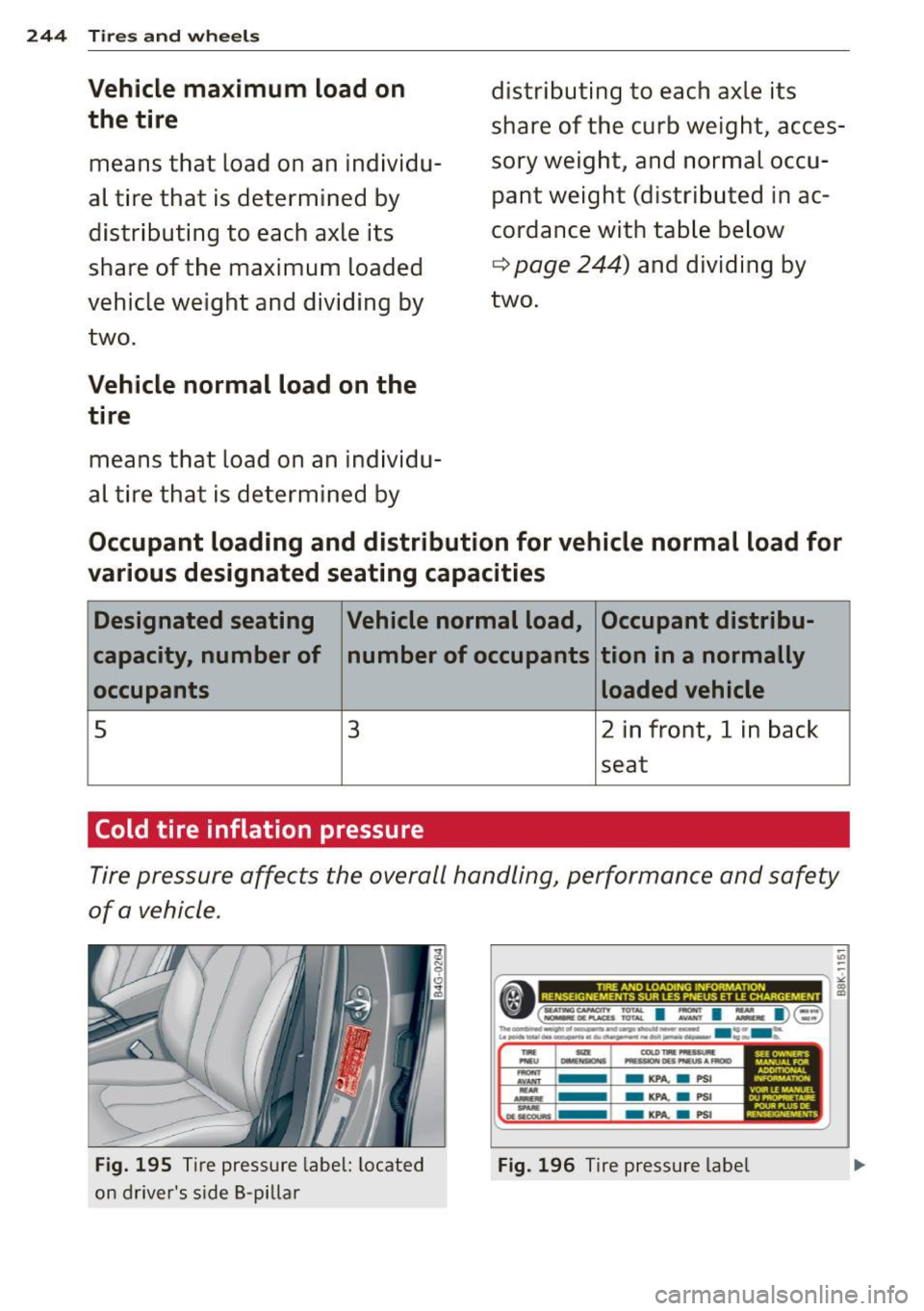
24 4 Tires a nd whee ls
Vehicle ma ximum load on
the tire
means that load on an individu
al tire that is determ ined by
distr ibuting to each axle its
share of the maximum loaded
vehicle weight and div iding by
two.
Vehicle normal load on the
tire
means that load on an in div idu
al tire that is determ ined by d
istribut ing to each axle its
share of the curb weight, acces
sory weight, and normal occ u
pant weigh t (distributed in ac
cordance with table below
¢ page 244) and dividing by
two .
Occupant loading and distribution for vehicle normal load for
v arious designated seating capac it ies
Designated seating Vehicle normal load, Occupant distribu-
capacity , number of number of occupants tion in a normally
occupants loaded vehicle
5 3 2 in front, 1 in back
seat
Cold tire inflation pressure
Tire pressure affects the overall handling, performance and safety
of a vehicle.
F ig. 1 95 Tire pressure label: located
on driver's side 8-pillar
~----------~"'
MW OWE lSlllHS P'RES5l0H OES f'Nall A, FIIICJD
:"" -ICPA. • PSI
.::. -KPA.. . PSI
°'~ -KPA. -PSI
Fig. 1 96 Tire pressure label
Page 247 of 314
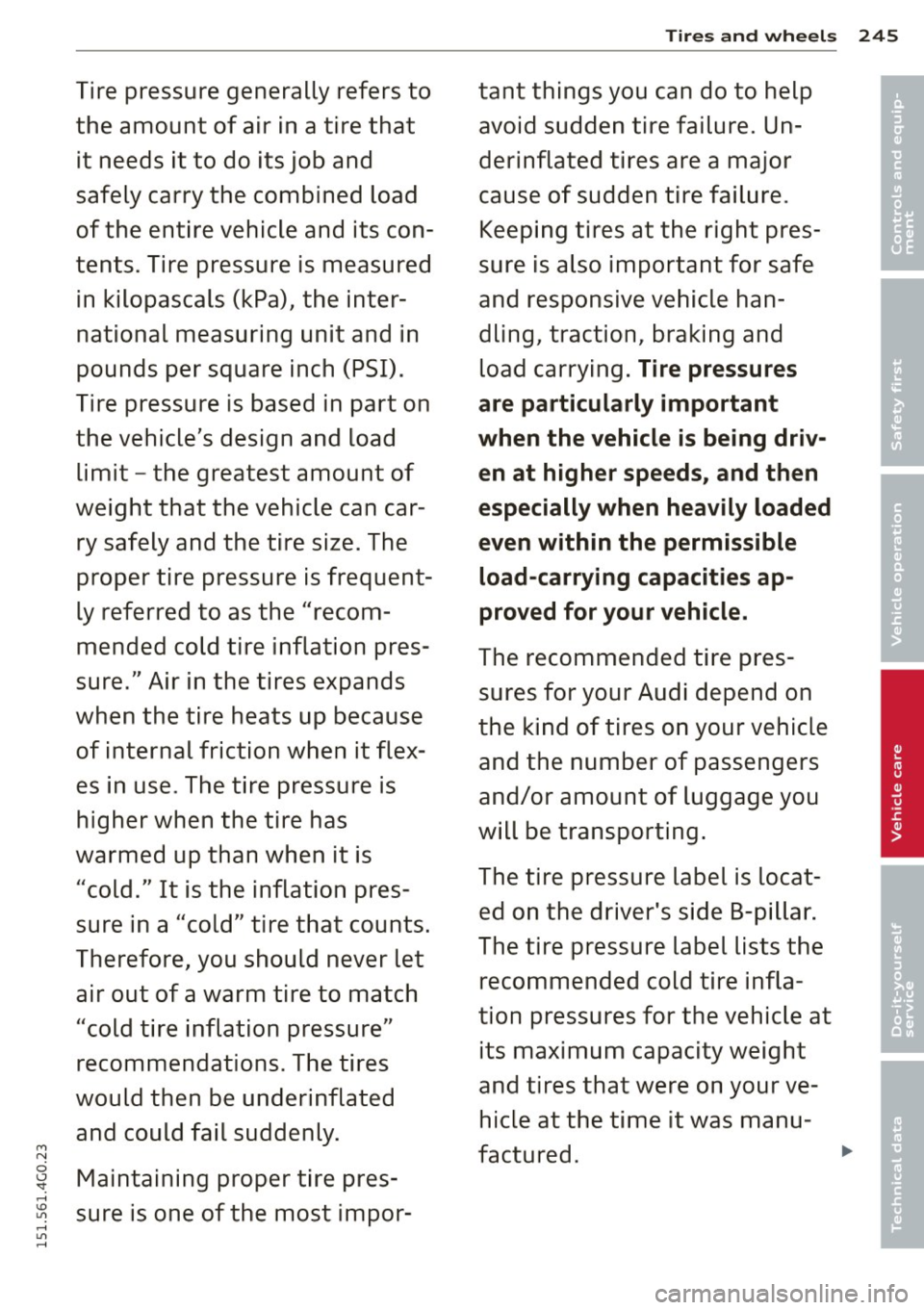
Tires and wheels 245
Tire pressure generally refers to tant things you can do to help •
the amount of air in a tire that avoid sudden tire failure. Un-• '
it needs it to do its job and derinflated tires are a major
safely carry the combined load cause of sudden tire failure. of the entire vehicle and its con- Keeping tires at the right pres-
tents. Tire pressure is measured sure is also important for safe
in kilopascals (kPa), the inter- and responsive vehicle han-
national measuring unit and in dling, traction, braking and
pounds per square inch (PSI) . load carrying.
Tire pressures
Tire pressure is based in part on are particularly important
the vehicle's design and load when the vehicle is being driv-
limit - the greatest amount of en at higher speeds, and then
weight that the vehicle can car -especially when heavily loaded
ry safely and the tire size. The even within the permissible
proper tire pressure is frequent-load-carrying capacities ap-
ly referred to as the "recom-proved for your vehicle.
mended cold tire inflation pres-The recommended tire pres-
sure ." Air in the tires expands
sures for your Audi depend on
when the tire heats up because the kind of tires on your vehicle
of internal friction when it flex- and the number of passengers
es in use. The tire pressure is and/or amount of luggage you
higher when the tire has will be transporting.
warmed up than when it is The tire pressure label is locat-
"cold. " It is the inflation pres-
ed on the driver's side B-pillar.
sure in a "cold" tire that counts.
Therefore, you should never let The tire pressure label lists the
recommended cold tire infla-
air out of a warm tire to match
"cold tire inflation pressure" tion pressures for the vehicle at
its maximum capacity weight
recommendations. The tires
would then be underinflated and tires that were on your ve
-
and could fail suddenly. hicle at the time it was manu-
M factured
. N
0
Maintaining proper tire pres-<.J 'SI: ,...., \!)
sure is one of the most impor-1.1'1 ,...., 1.1'1 ,....,
Page 248 of 314
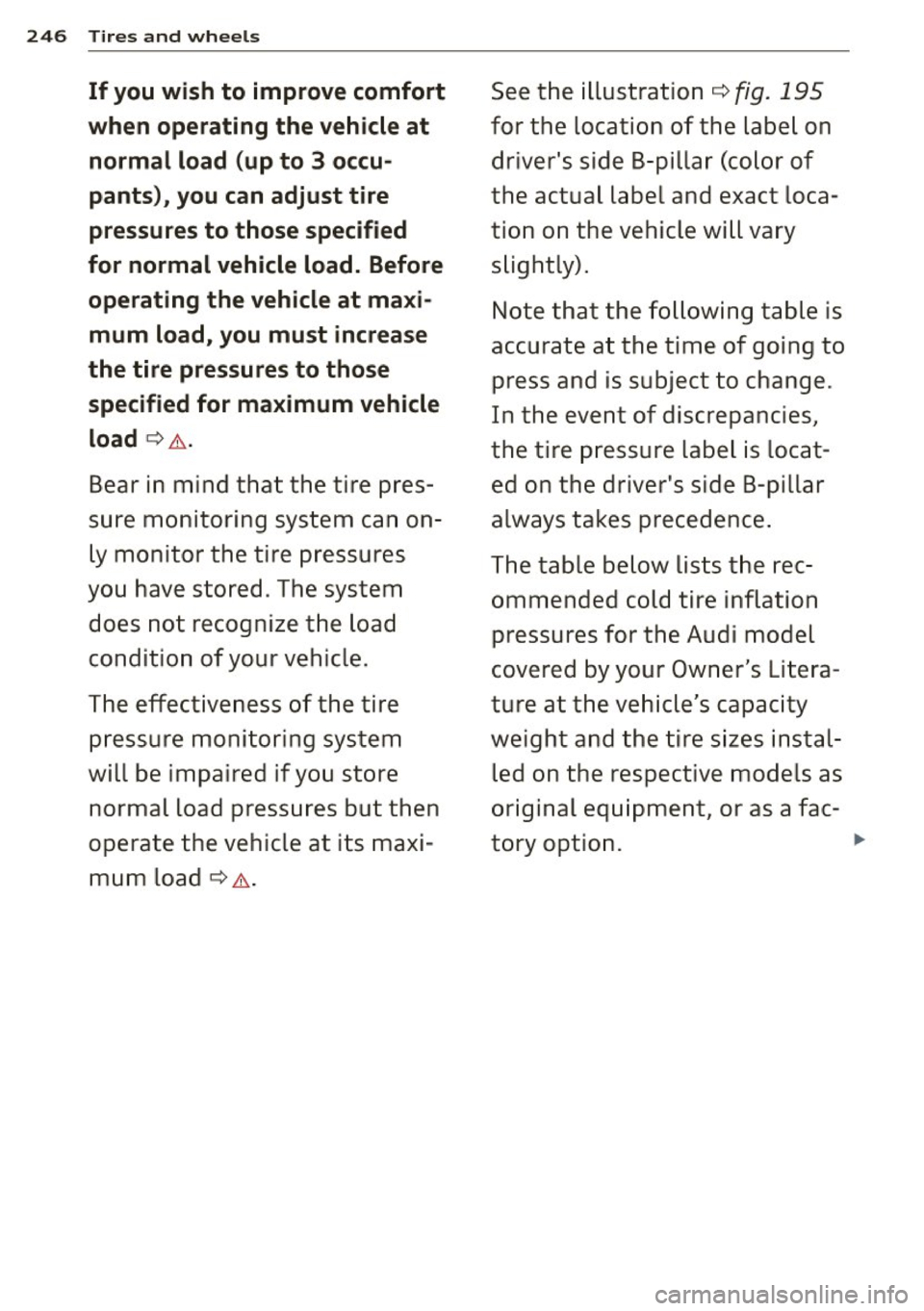
246 Tires and wheel s
If you wish to improve comfort See the illustration ¢ fig. 195
when operating the vehicle at for the locati on of the labe l on
normal load (up to 3 occu -driver's side B -pillar (color of
pants), you can adjust tire the actual label and exact loca-
pressures to those specified tion on the vehic le will vary
for normal vehicle load. Before slight ly) .
operat ing the vehicle at maxi -Note that the following table is
mum load , you must increase accurate at the time of going to
the ti re pressu res to those press and is subject to change .
specified for maximum vehicle In the event of discrepancies,
load¢&. the tire pressure labe l is locat-
Bear in mind that the tire pres- ed on the driver's side 8-pi llar
sure monitoring system can on -always takes precedence .
ly monitor the tire pressures The table below lists the rec-
you have stored . The system
ommended cold tire inflation
does not recogn ize the load
pressures for the Audi model
condition of your vehic le.
covered by your Owner's Litera-
T he effectiveness of the tire ture at the vehicle's capacity
pressure monitoring system weight and the tire sizes instal -
will be impaired if you store led on the respective mode ls as
normal load pressures but then original equipment, or as a fac-
operate the vehicle at its maxi- tory option.
...
mum load¢&.
Page 250 of 314
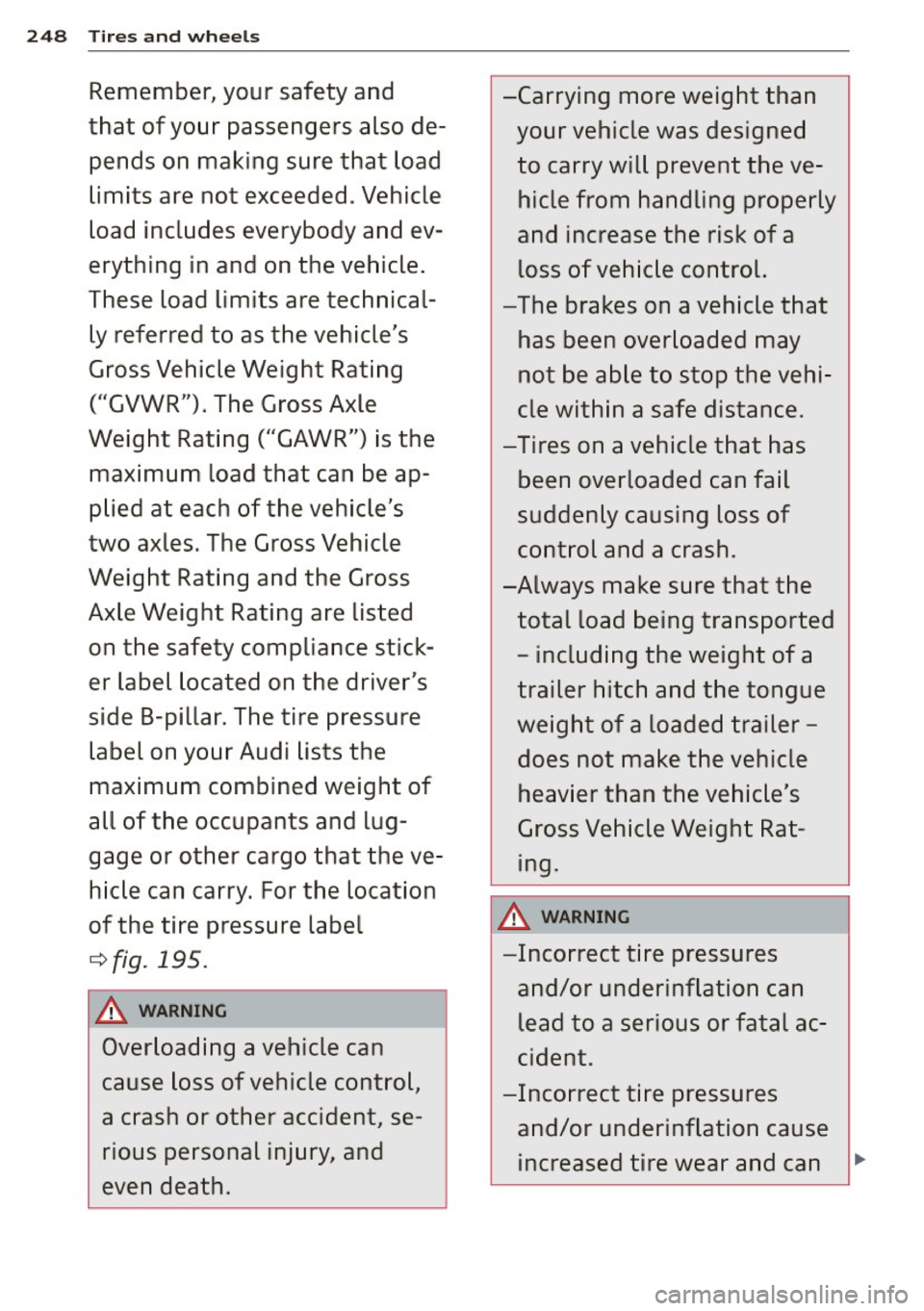
248 Tires and wheels
Remember, your safety and
that of your passengers also de pends on making sure that load
limits are not exceeded . Vehicle
load includes everybody and ev
erything in and on the vehicle.
These load limits are technical
ly referred to as the vehicle's
Gross Vehicle Weight Rating ("GVWR"). The Gross Axle
Weight Rating ("GAWR") is the
maximum load that can be ap
plied at each of the vehicle's
two axles. The Gross Vehicle
Weight Rating and the Gross
Axle Weight Rating are listed
on the safety compliance stick
er label located on the driver's
side B-pillar. The tire pressure
label on your Audi lists the
maximum combined weight of
all of the occupants and lug
gage or other cargo that the ve
hicle can carry. For the location
of the tire pressure label
¢fig. 195.
.&_ WARNING
-
Overloading a vehicle can
cause loss of vehicle control,
a crash or other accident, se
rious personal injury, and
even death. -Carry
ing more weight than
your vehicle was designed to carry will prevent the ve
hicle from handling properly
and increase the risk of a
loss of vehicle control.
-The brakes on a vehicle that
has been overloaded may not be able to stop the vehi
cle within a safe distance.
-Tires on a vehicle that has
been overloaded can fail
suddenly causing loss of
control and a crash.
-Always make sure that the total load being transported
- inclu ding the weight of a
trailer hitch and the tongue
weight of a loaded trailer -
does not make the vehicle
heavier than the vehicle's
Gross Vehicle Weight Rat
ing.
A WARNING
-Incorrect tire pressures
and/or underinflation can lead to a serious or fatal ac
cident.
-Inco rrect tire pressures
and/or underinflation cause
increased tire wear and can .,.
Page 251 of 314
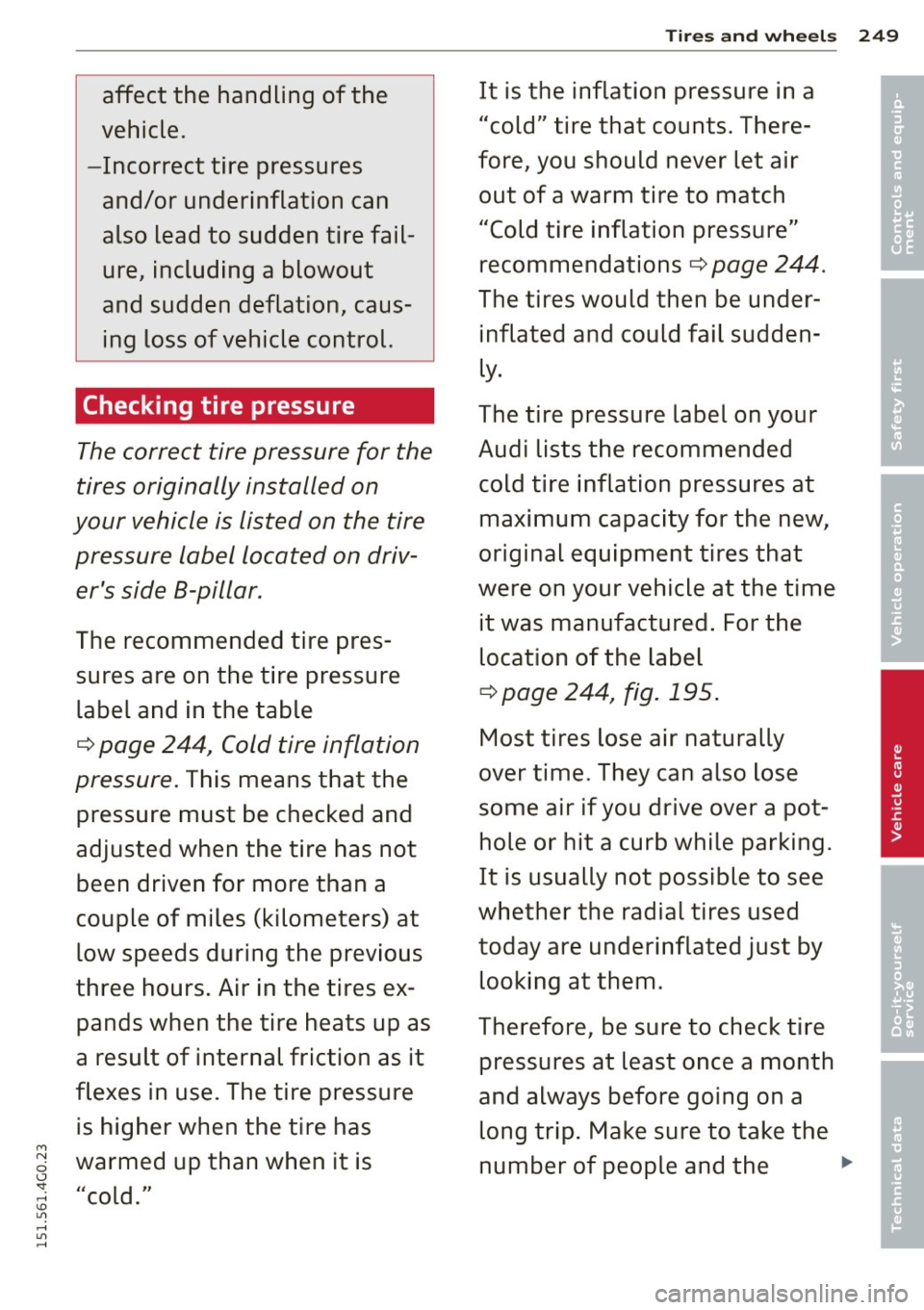
M N
0 <.J 'SI: ,...., \!) 1.1'1 ,...., 1.1'1 ,....,
affect the handling of the
vehicle.
- Incorrect tire pressures
and/or underinflation can
also lead to sudden tire fail ure, including a blowout
and sudden deflation, caus
ing loss of vehicle control.
Checking tire pressure
The correct tire pressure for the
tires originally installed on
your vehicle is listed on the tire pressure label located on driver's side 8-pillar .
The recommended tire pres
sures are on the tire pressure
label and in the table
c> page 244, Cold t ire inflation
pressure.
This means that the
pressure must be checked and
adjusted when the tire has not
been driven for more than a
couple of miles (kilometers) at
low speeds during the previous
three hours . Air in the tires ex
pands when the tire heats up as
a result of internal friction as it
flexes in use . The tire pressure
is higher when the tire has
warmed up than when it is "cold."
Tires and wheels 249
It is the inflation pressure in a
"cold" tire that counts. There
fore, you should never let air out of a warm tire to match
"Cold tire inflation pressure"
re commendations
c> page 244 .
The tires would then be under
inflated and could fail sudden
ly.
The tire pressure label on your
Audi lists the recommended cold tire inflation pressures at
maximum capacity for the new,
original equipment tires that
were on your vehicle at the time
it was manufactured. For the
location of the label
c> page 244, fig. 195.
Most tires lose air naturally
over time . They can also lo se
some air if you drive over a pot hole or hit a curb while parking.
It is usually not possible to see
whether the radial tires used
today are underinflated just by looking at them .
Therefore , be sure to check tire
pressures at least once a month
and always before going on a long trip. Make sure to take the
number of people and the .,.
•
•
'
Page 252 of 314
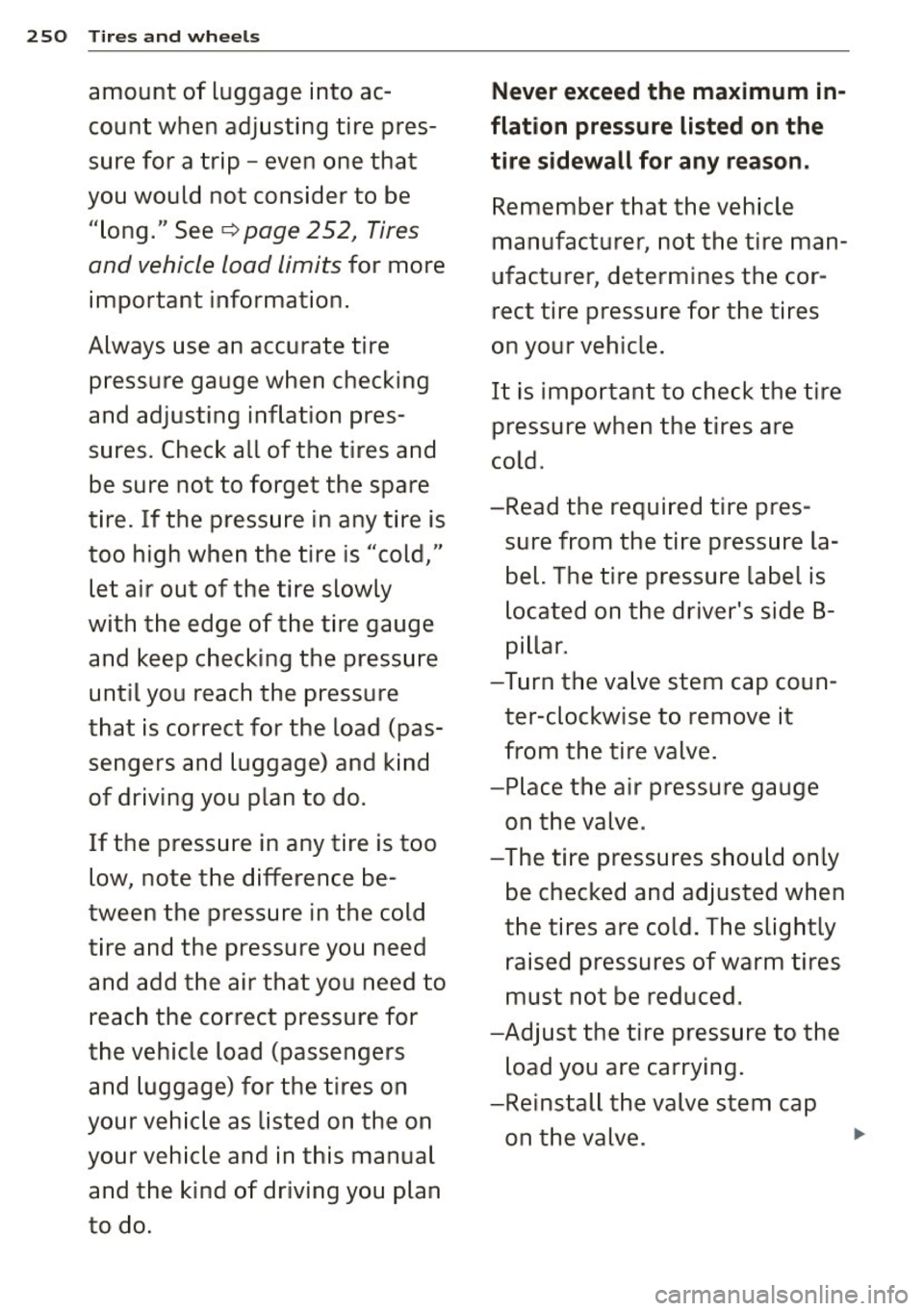
250 Tires and wheels
amount of luggage into ac-Never exceed the maximum in-
count when adjusting tire pres-flation pressure listed on the
sure for a trip -even one that tire sidewall for any reason.
you would not consider to be
Remember that the vehicle
"long." See
q page 2 52, Tires manufacturer, not the tire man-
and vehicle load limits for more ufacturer, determines the car-
important information. rect tire pressure for the tires
Always use an accurate tire on your vehicle.
pressure gauge when checking It is important to check the tire
and adjusting inflation pres- pressure when the tires are
sures. Check all of the tires and cold.
be sure not to forget the spare -Read the required tire pres-
tire. If the pressure in any tire is
sure from the tire pressure la-
too high when the tire is "cold,"
bel. The tire pressure label is
let air out of the tire slowly
located on the driver's side B-
with the edge of the tire gauge
pillar.
and keep checking the pressure
-Turn the valve stem cap coun-
until you reach the pressure
ter-clockwise to remove it
that is correct for the load (pas-
from the tire valve.
sengers and luggage) and kind
-Place the air pressure gauge
of driving you plan to do .
on the valve.
If the pressure in any tire is too -The tire pressures should only
low, note the difference be-
be checked and adjusted when
tween the pressure in the cold the tires are cold. The slightly
tire and the pressure you need
raised pressures of warm tires
and add the air that you need to must not be reduced.
reach the correct pressure for -Adjust the tire pressure to the
the vehicle load (passengers load you are carrying.
and luggage) for the tires on
-Reinstall the valve stem cap
your vehicle as listed on the on on the valve.
...
your vehicle and in this manual
and the kind of driving you plan
to do.